2018 has been a transitory year for cryptocurrency, and it seems as though the focus is transitioning from “HODL” to “BUIDL.” While prices are taking their sweet time correcting, blockchain development is in full force, preparing for the next bull run so many of us are hoping for.
In this article, we’ll take a look at what the top 10 cryptocurrencies are doing with their capital. For clarification, there are some discrepancies between which cryptos are in the top 10 according to who you hear it from. Why those differences exist, we’ll save for another article.
For this one, we’ll be referring to the Yahoo! Cryptocurrency Screener.
It’s also worth noting which of these projects are as yet without a working product: EOS, TRON, and Cardano. Of course, there are arguments to the contrary, but the line had to be drawn somewhere, and sometimes it’s useful to set the bar high. For more details on this evaluation, check out our article on cryptocurrencies with working products.
Tether aside, here’s what’s in store for the top 10 cryptocurrencies in 2019.
Top 10 Cryptocurrencies: Developments You Can Look Forward to in 2019
1. Bitcoin (BTC)
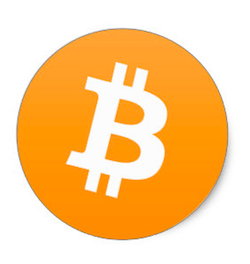
Bitcoin is setting itself up for an interesting 2019, and there’s 2 main reasons why: increasing transaction speed and scalability, and institutional investors closing in on approval.
This combination has the potential to launch the entire market into another bull run, although it will need time to gain traction.
Lightning Network
The 7-second transaction time plaguing Bitcoin’s usability has led to increased transaction fees and a stronger edge to the competition. Bitcoin developers are responding by rolling out the Lightning Network, which allows transactions to occur separately from Bitcoin’s main blockchain.
You can learn more about how Lightning Network works by clicking here, but simply put, solving current scaling issues would make Bitcoin feasible for mass adoption. Due to incoming institutional interest, the timing couldn’t be better.
Institutional Involvement
Massive financial institutions are warming up to cryptocurrencies, and releasing products to meet the demand.
Fidelity launched their Digital Assets platform in Q4 2018, and are scheduled to launch the Fidelity Digital Asset Services (FDAS) platform in Q1 2019 to meet rising demand. The FDAS launch would give their clients access to a majority of the top 10 cryptocurrencies, instead of limiting access to Bitcoin and Ethereum.
Then there’s the launch of Bakkt, delayed until Q1 2019, which will provide regulatory compliance for cryptocurrencies, and also offer Bitcoin futures contracts.
2. Ripple (XRP)

Like many of the altcoins, there isn’t a detailed roadmap publicly available for Ripple. To get an understanding of what 2019 will bring for XRP, we need to take a look at what the Ripple team has been up to, and what they’re aiming for.
Fast and Scalable
While Bitcoin hopes to tackle scalability issues next year, Ripple software is already capable of consistently handling 1,500 transactions per second (Tx/s), which is basically identical to Visa’s average of 1,700 Tx/s.
To put these numbers into perspective, consider the image below, which shows the transaction times of the top 3 cryptocurrencies versus traditional systems. The speed blockchain technology brings to the table is impressive, and Ripple is at the head of the pack.
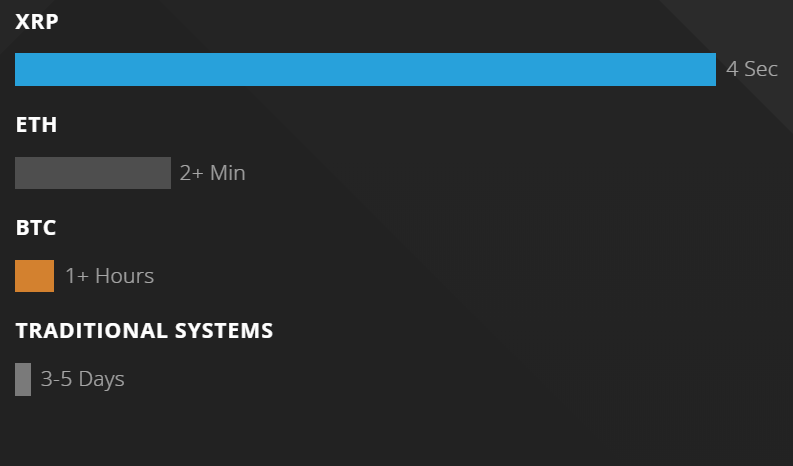
Global Bank Partnerships
Not only is Ripple capable of handling transactions thousands of times faster than any other major payment gateway, they’re able to do so internationally. Ripple has been focusing on acquiring partnerships with RippleNet, which is a global payments network aimed at increasing liquidity and lowering transaction fees.
There are currently well over 100 RippleNet partners, some of the most notable being American Express, MoneyGram, and SWIFT. While these partnerships don’t automatically equate to a rise in XRP’s price, it seems as if the plan has been to create a digital asset that can handle global volume, establish significant partnerships, then incentivize said partners with value and savings.
Ripple has essentially accomplished a scalable ecosystem and powerful partnerships, and in 2019 we could very well see incentivized Ripple partners.
3. Ethereum (ETH)

Ethereum is an important piece of the industry, and it made its entrance in 2014 as the first cryptocurrency to enable smart contracts and dapps to be built on top of it.
This has led to 94 of the top 100 coins being built on Ethereum. However, the sharp rise in activity on the blockchain has also brought growing pains along with it, in the form of scalability issues.
Scalability Solutions
Ethereum founder Vitalik Buterin seems confident in his solution to the blockchain’s current lack of scalability. The first update, called Constantinople, would require an Ethereum hard fork, and could happen as soon as January 2019.
The second upgrade would introduce the Casper protocol as well as sharding, which would happen in the later half of 2019.
The next scheduled update is called Serenity, which requires the creation of an entirely new blockchain, and is a multi-update plan to move Ethereum from a Proof-of-Work consensus algorithm to Proof-of-Stake.
Ethereum has a strong, proactive response to the scalability issues that came to a head throughout 2017 and 2018. With multiple cryptocurrencies battling for the top platform coin spot, Ethereum will need to make the most of next year if it wants to hold onto its first mover advantage.
4. Bitcoin Cash (BCH)
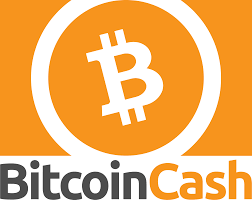
Despite the hash wars of 2018, Bitcoin Cash remains ranked at #4, and their recently updated website comes complete with a roadmap for 2019, which has been divided into 3 sections: scaling, usability, and extensibility.
The team admits that although they believe the design of their product is sound, it is not perfect, and requires carefully implemented upgrades if it wants to accomplish its aim to become “usable by everyone in the world.”
Their 3 main goals are:
- Bring Bitcoin Cash’s capabilities from 100 Tx/s to over 5,000,000 Tx/s.
- Shorten average transaction time to 3 seconds.
- Create an extensible protocol that makes future updates easier to implement.
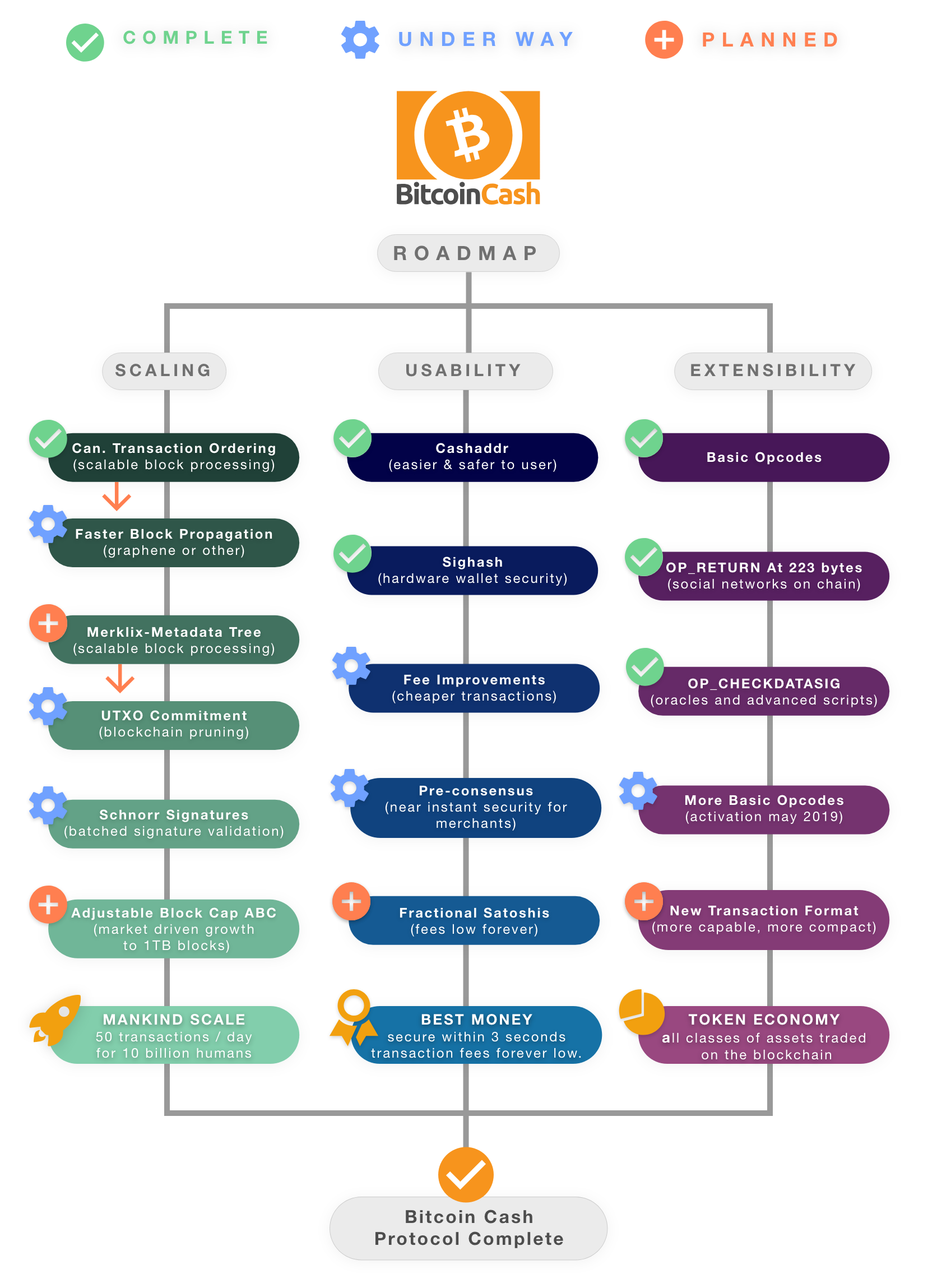
This roadmap is intended to provide high-level technical direction, and enable different technical teams to work together towards a common goal for advancing Bitcoin Cash.
—Bitcoincash.org
Aside from the regularly scheduled maintenance that’s set for May 2019, there is another developmental upgrade set to launch sometime next year called Coin Shuffle. The protocol will add an extra privacy layer, obfuscating transactional data at no additional fee.
5. Stellar (XLM)

The cryptocurrencies that are able to make developmental improvements, as well as partnerships, during bear markets are the ones that stand the best chance of survival.
While we haven’t been blessed with a roadmap for 2019 yet, we can start to put the picture together already based on what Stellar accomplished throughout 2018.
Stellar is similar to Ripple in a few ways, but 1 of the most prominent similarities moving into 2019 is their success in building partnerships with massive corporations, and what their plans for next year entail.
IBM and Blockchain World Wire
IBM has been an industry leader in in the computer field, so it’s not surprising they’re looking into blockchain technology ahead of the curve. A partnership with IBM is almost like a shortcut into the financial industry.
According to IBM’s website, 90% of credit card transactions are processed using the IBM mainframes, and 97% of world banks are IBM clients.
IBM is in the process of launching Blockchain World Wire (BWW), which they describe as “the new financial rail that simultaneously clears and settles cross-border payments in near real-time”— and they have chosen Stellar to be the platform behind it all.
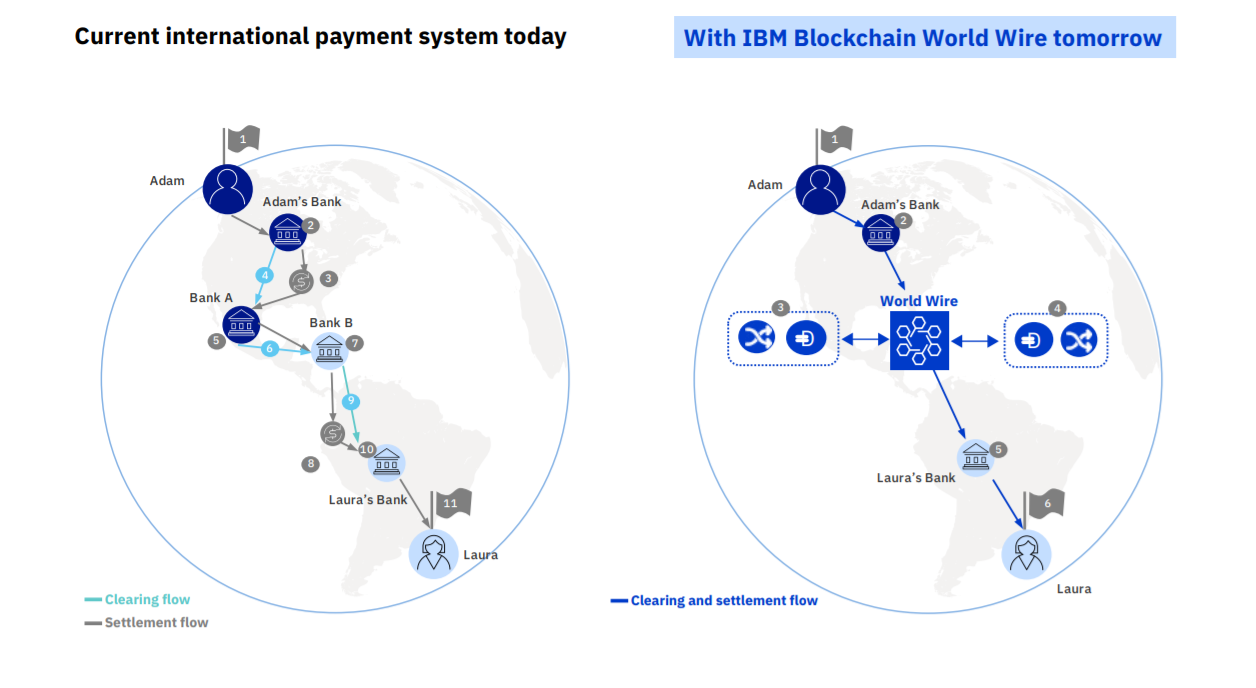
2019 should be the first year the BWW sees significant traction, which should boost Stellar on the crypto radar considerably.
6. Litecoin (LTC)
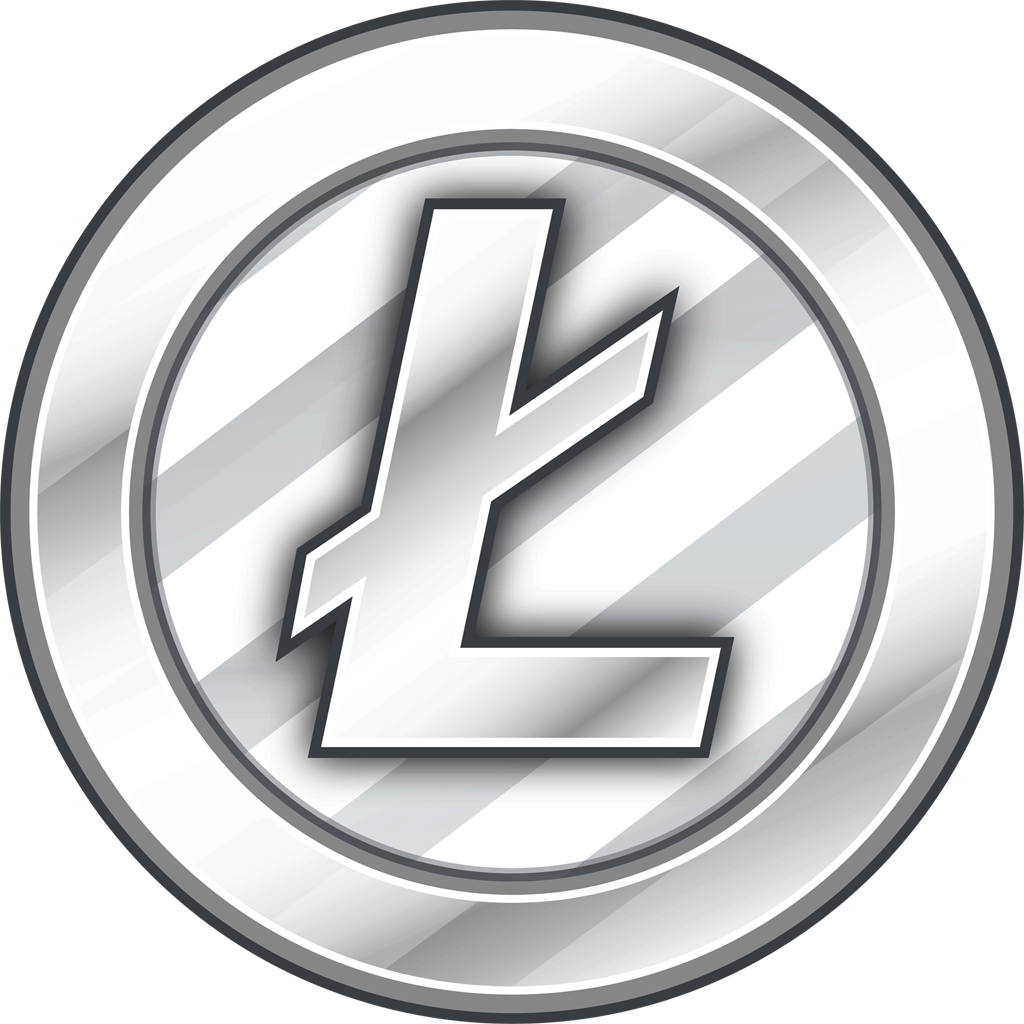
Litecoin is commonly referred to as the silver to Bitcoin’s gold, given users’ proclivity to store their Bitcoin rather than use it for everyday transactions. It’s a loose analogy, but Litecoin’s goal as “silver” is to come in a smaller denomination than BTC, and thus be more practical to use for everyday transactions.
It’s worth noting that in general, since Litecoin is a fork of Bitcoin, Litecoin updates happen after those of Bitcoin. That said, Litecoin has a few technological updates due for release throughout 2019.
Mainnet Update
Litecoin transaction fees are set to take a significant dive with the release of Litecoin Core 0.17, which was announced in October 2017. The announcement post started off by claiming the update would reduce fees by a factor of 10, bringing the average transaction cost from $0.05 to $0.005.
Lightning Network and Private Transactions
As Bitcoin developers build and release the Lightning Network, Litecoin developers will be right behind them, looking to lower transaction times and costs even further. The founder of Litecoin, Charlie Lee, also hinted at the development of private transactions in a recent interview.
7. EOS (EOS)

The current EOS roadmap isn’t very detailed in terms of dates, but we can assume a major focus in 2019 will be the funding and development of dapps within the EOS ecosystem.
We can also assume they’ll be implementing updates on the mainchain to make it an attractive option for blockchain developers.
It’s difficult to know for sure what will be taking place next year. The official EOS roadmap vaguely points out that their 5th and final phase, titled Cluster Implementation, will occur sometime in the future.
Aside from that, the most convincing information publicly available is on EOS.io’s StackExchange, and it provides details on what EOS developers will be focused on next.
The EOS answer to the scalability question involves the utilization of sidechains and sisterchains, which would require the finishing of their Inter-Block Communication (IBC) protocol.
It’s also likely that EOS will be working to improve their irreversibility times by working on the asynchronous Byzantine fault tolerant (aBFT) protocol. For a technical, in-depth overview of aBFT, check out this video by Dan Larimer, the founder of EOS.
8. TRON (TRX)
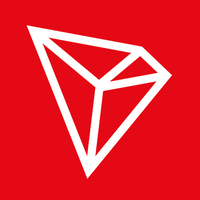
TRON has grown immensely since its mainnet launch in June 2018, reaching an impressive ranking of #8 in terms of marketcap. They’ve also managed to exceed Ethereum dapp usage in this short time frame, making it a serious platform coin contender.
On top of that, TRON has a list of ambitious goals set for 2019.
User Privacy
The CEO of TRON, Justin Sun, recently explained that TRON will implement zk-SNARKS technology, giving users the option to obfuscate their transaction information. The update is scheduled to take place as soon as Q1 2019.
Stage 2: Odyssey
TRON is currently operating on a 6-stage plan, and Stage 2 is set to begin in early 2019.
The main goal of 2018 was implementing Stage 1, which can be summarized as getting the Tron mainnet up and running. Stage 2 focuses on solidifying the overall use case of their ecosystem.
Titled Odyssey, Stage 2 will focus on dapp creation and distribution, as well as compensation for said content via TRX. Their recent acquisition of BitTorrent will undoubtedly be utilized to prove Tron’s capabilities.
9. Binance Coin (BNB)

In a Christmas Eve blog post, Binance CEO Changpeng “CZ” Zhao reviewed Binance’s developments throughout 2018, and went on to describe what 2019 has in store. The post was mostly about the Binance exchange itself, but there was some mention of the BNB token specifically.
That said, BNB is tightly woven into Binance’s ecosystem, with users incentivized to use the token in return for reduced fees.
Binance in 2019
Taken straight from the year-end review, here’s what Binance’s CEO sees for Binance next year.
- More features on Binance.com.
- Binance Chain mainnet live, with a native high-performance DEX, as well as 1-second transaction confirmation time, enabling true instant transactions.
- Up to 10 fiat exchanges around the world.
- More partnerships with industry leaders.
- More use cases and adoption of BNB.
- More interesting projects invested in or acquired by Binance.
- True transparent charities.
Not only is Binance working to solidify their position as 1 of the best crypto exchanges in the world, but they’re looking into additional use cases for their native token, BNB.
10. Cardano (ADA)

Out of all the projects in this article, Cardano has the most detailed roadmap publicly available, and they even have a countdown available for their next roadmap update.
Charles Hoskinson, the founder of Cardano, maintains a high level of communication with the community and consistently releases video updates on the project.
Cardano’s academic approach is slow and steady, and they have a lot on their plate. Here are some of the more notable items on that list.
Shelley and Staking
Shelley is the next step for Cardano, and it’s aiming to produce a fully decentralized ecosystem. The update is scheduled to release in early 2019, beginning with the implementation of voting and stake pool testnets.
Cardano experiments have revealed their ecosystem is able to handle 1,000 stake pools, so now they’re focused on creating a user-friendly way of presenting so many options to their users.
Ledger Wallet and Light Client Support
At the time of writing, wallet options for ADA are mostly limited to the Daedalus desktop wallet (which requires the user to download the entire blockchain), or the light wallet Yoroi. In 2019, we’re likely to see Ledger wallet support, as well as a light option when using the Daedalus wallet.

